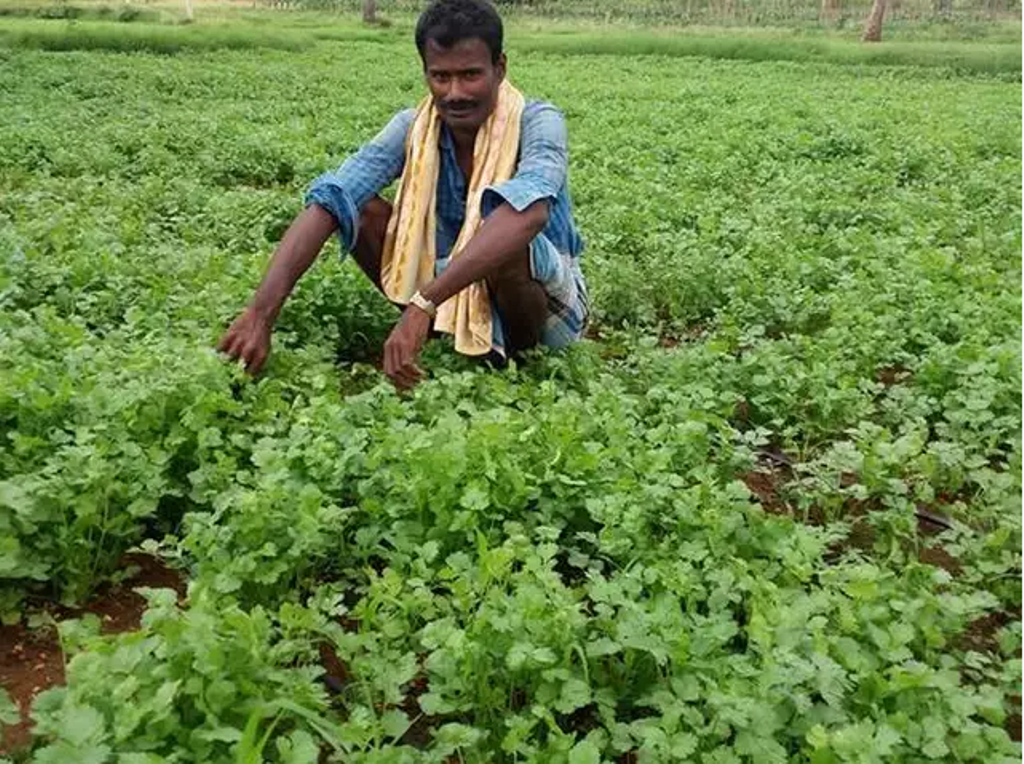
Coriander (Dhaniya) is an annual herb with scientific name Coriandrum sativum. It is cultivated mainly for its fruits as well as for the tender green leaves. It is native of the Mediterranean region, and grown in Andhra Pradesh, Tamil Nadu, Karnataka, Rajasthan and Madhya Pradesh. Most of the production is being consumed locally and a smaller percentage goes for exports. The fruits have a fragrant odor and pleasant aromatic taste. The odor and taste due to essential oil content, which varies from 0.1 to 1.0 % in the dry seeds. These essential oils are used for flavoring liquors, coca preparations in confectionary and also to mask the offensive odors in pharmaceutical preparations.
The dried ground fruits are the major ingredients of the curry powder. On the other hand the whole fruits are used to favour foods like pickles, sauces and confectionary. The young plants as well as the leaves are used in the preparation of chutney and are also used as seasonings in curries, soups, sauces and chutneys. It has medicinal properties too and fruits of this herb are known for its carminative, diuretic, tonic, stomachic and aphrodisiac properties. Coriander belongs to the family Apiaceae.
|
Variety |
Characteristics |
|
CO1 |
It was released by TANU, Coimbatore. Plant is taller in height with many umbels per plant. It is suitable for green and grains. Duration is 110 days while yield is 500 kg per ha. |
|
CO2 |
Released by TANU, Coimbatore. High yield, dual purpose variety, tolerant to drought, oil 0.3%. Duration 90-110 days. Yield 600-700 kg per ha. |
|
CO3 |
Released by TANU, Coimbatore. High yield, dual purpose, grain is medium sized; seed oil content is 0.38-0.41%. Duration 103 days and Yield is 40 kg per ha. |
|
Gujarat Corinader-1 |
Released by GAU, Jagudan. High yield, more number of branches, seeds are bolder and with greenish color. Duration 112 days. Yield 1100 kg per ha. |
|
Gujarat Coriander-2 |
Released by GAU, Jagudan. High yield, more branches, dense, foliage, umbels large size, grain purpose variety, bold seeds, no lodging. Duration 110-115 days. Yield 1500 kg per ha. |
|
Rajendra Swati |
Released by RAU, Dholi. Yield potential is high, suitable for intercropping, fine seeded, rich in essential oil and resistant to stem gall disease. Duration is 110 days. Yield 1200-1400 kg per ha. |
|
Rcr-41 |
Released by RAU, Jobner. It is tall, erect, suitable for irrigated areas, and resistant to stem gall. Duration 130-140 days. Yield 1200 kg per ha and it is a high yielding variety. |
|
Swati |
Released by APAU, Guntur. Semi erect and suitable for delayed sowing. Duration 80-90 days while Yield 885kg per ha. Also, high yielding. |
|
Sadhana |
Released by APAU, Guntur. High yielding and suitable for rainfed areas. It is semi erect, resistant to aphid and mites. Duration 95-105 days. Yield is 1000 kg per ha. |

Climate and Soil Requirements
Dhaniya or Coriander is cultivated mainly for leaf purpose. For obtaining higher grain yield it has to be grown in specific season. Grain production is better when grown in a dry and cold weather, free from frost especially during flowering and fruit setting stage. Cloudy weather during flowering and fruiting stage is not preferable since this supports pest attack and diseases. Heavy rain on the other hand damages the crop. As an irrigated crop, it can be cultivated on almost all types of soils provided sufficient organic matter is applied. Under rainfed conditions it is best suited to grow in black cotton soils.
Preparation of Land
For rainfed areas, the land is ploughed 3 to 4 times, before the rainy season. After a heavy rain the field must be planted immediately to break the clods and to avoid soil moisture. For irrigated crop the land is ploughed twice or thrice and beds and channels are built then.
Seeding
Coriander is basically grown as a Rabi season crop In the North and Central parts of India and Andhra Pradesh. Seeding or sowing is done between middle of October and middle of November. In certain regions of above mentioned states it is grown as late Kharif crop also, and its planting season falls between August and September.
In Tamil Nadu coriander is raised in June-July and September-October as an irrigated crop. In one hectare of land, recommended seed rate is 10 to 15 kgs. Seeds if stored for 15 to 30 days, and then planted, have produced yields and germinate earlier when compared with the freshly harvested seeds. For enhancing percentage of germination seeds can be soaked in water for 12 to 24 hours before sowing. The seeds are split into two halves by rubbing and generally done in rows spaced at 30 to 40 cm apart with 15 cm between hills. Soil depth should be equal or less than 3.0 cm. Three to five seeds are sown in seeds are broadcast and covered with country plough. Normally it takes about 10-15 days for coriander seeds to germinate.
Application of Manures and Fertilizers: (Kg/Acre)
About 10 tonnes of farmyard manure is applied at the time of last preparation. In addition, the following fertilizers may be applied.
|
Name |
N |
P |
K |
|
|
Basal |
30 days after sowing |
Basal |
Basal |
|
|
Irrigated crop |
15 |
15 |
40 |
20 |
|
Rainfed crop |
20 |
- |
30 |
20 |
Irrigation
First irrigation is given 3 days after sowing. Thereafter, irrigation is done at 10 to 15 days interval depending upon the soil moisture available in the soil.
Interculture
After 30 days of sowing, first hoeing and weeding is done. Leaves are reduced simultaneously, leaving only two plants per hill. Depending upon the growth one or two more weeding are done.
Harvesting and yield
The crop normally gets ready for harvest in about 90 to 110 days depending upon the varieties and growing season. Harvesting should be considered once the fruits ripen completely and change color from green to brown. In harvesting process the plants are cut or pulled and poled into small stacks in the field to beating with sticks or rubbing with hands. The produce is winnowed, cleaned and dried in partial shade. After drying, the produce is stored in gunny bags lined with paper. Yield of Dhaniya as rainfed crop averages between 400 to 500 kg/ha, while yield for the irrigated crop is between 600 to 1200 kg/ha.

Plant protection Methods
Coriander crop is often attacked by the leaf eating caterpillars and semi-loopers during the seedling stage and aphids during the flowering stage. Spraying the crop with methyl demeton (0.05%) is recommended to control the aphids but this should be avoided during the flowering stage as the use of any insecticide would kill the bee population affecting pollination in the crop, during this period.
Powdery mildew (Erysiphe polygoni) is a serious disease for Dhaniya crop and to control this, spraying wettable sulphur 0.25% or 0.2% solution of Karathane twice at 10 to 15 days interval, is the recommendation. Another disease is Grain mould which is caused by Helminthosporium sp., Alternaria sp., Carvularia sp. and Fusarium sp. It can be controlled by spraying carbendazim 0.1% 20 days after grain setting.
Economics Of Coriander / Dhaniya Cultivation
|
Activity |
Cost per Acre (Rs) |
Explanation |
|
Seed Purchase Cost |
500 |
250 gm of coriander seed is required for one acre land. Cost of 250 gm seed is Rs.500 |
|
Land Rent |
1000 |
Taking average value of the land to be cultivated |
|
Seed Treatment Cost |
2000 |
Seed treatment done with 1gm carbendazim or 2.5 gm mancozeb per kg coriander, 3 days before sowing. Farm Yard Manure (FYM) also used. Costs of these amounts to Rs.1500-2000. |
|
Cost of Ploughing |
4000 |
Includes operations like Ploughing and Nursery seedbed preparation and shade net construction. |
|
Transplantation Cost |
1000 |
Done twice with 2 laborers, each time |
|
Labor Cost |
2500 |
Laborers needed for irrigation, harvesting and weeding or intercultural operations. 2 laborers needed per day, 5 times. Cost of one labor is Rs.200-250. |
|
Pesticide and Fertilizer cost |
2000 |
Fertilizers like 1kg SSP, 150 gm MOP 350 gm Urea. Fungicides also applied. |
|
Harvesting Cost |
3000 |
Done at least 5-6 times. Two laborers needed per harvest. Therefore cost is between Rs.2500-3000. |
|
Marketing Cost |
3000 |
Included transportation expenses to nearest available markets, per harvest. So this cost is incurred at least 5 times, which amounts to Rs.3000 approximately. |
|
Miscellaneous Cost |
5000 |
Comprises shade net construction expense, charges for cultural equipment used, and few other accessory costs. |
|
Total Cost |
24000 |
|
On an average the yield per acre is 20 quintals per acre if proper cultivation and farm management practices are adopted. Current market rates of NCDEX specified Coriander prices are averaging near Rs.6800 per quintal. So the net realization from one acre land will generate Rs.1, 36000. Adjusting the production cost per acre of Rs.24000, net profit earned per acre will be Rs.1, 12,000 approximately. Therefore returns are quite impressive in Dhaniya/Coriander cultivation in India.










